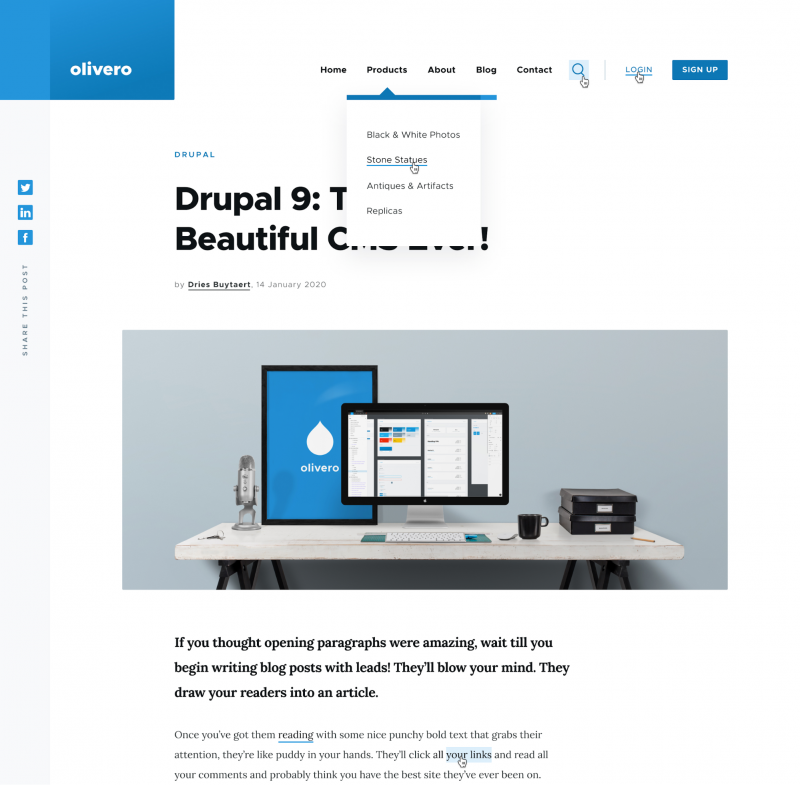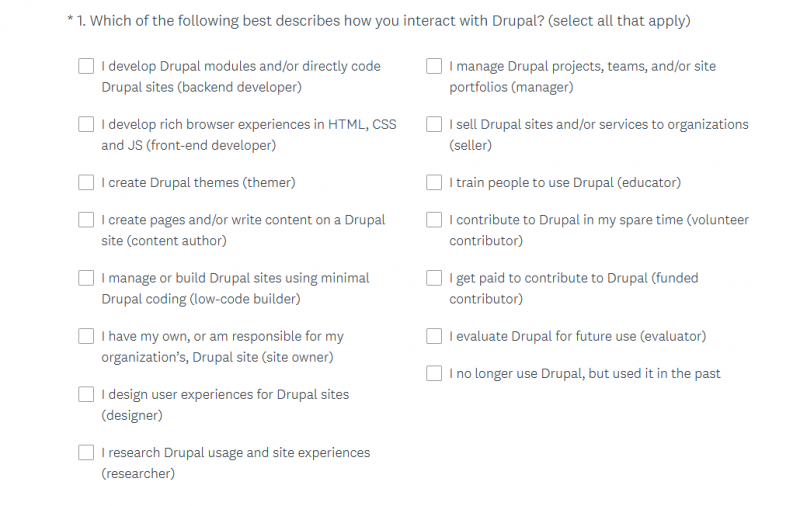Drupal 9.0 was launched earlier this month as a continuation of Drupal 8. This time around, the core update was more about updating the technology underlying Drupal's codebase and eliminating dependencies than introducing brand-new features, but fear not: we'll be getting some of those soon enough.
Drupal releases features on a semi-annual basis, and version 9.1 is expected to be rolled out around December this year.
Due to the decentralized nature of Drupal's development, the roadmap for 9.1 isn't necessarily set in stone; that said, the strategic initiatives and core objectives are well-documented, so we know what we can expect in the foreseeable future. Most importantly, gone are the days when Drupal was developer-first, editor-second: it's all about usability and accessibility for everyone moving forward.
Let's take a closer look at what that might entail. On the menu: a new front-end theme, automatic updates, and community-driven improvements collected from the 2020 Drupal Product Survey.
Olivero Front-End Theme
When I built my first-ever Drupal site during an Evolving Web training session, I remember thinking two things: "Wow, this is really flexible and fun to use once you get the hang of it", and "Wow, the default theme looks a bit dated". I'm a fan of Drupal, but the Bartik theme and its decade-old design just don't quite do it justice for first-time users.
Drupal has made it a major priority to completely overhaul its user experience and be friendlier for everyone, not just developers. Now that Claro, a new, accessible admin theme, is available in Drupal 9, contributors are focusing on Olivero, a modern front-end theme designed to showcase the CMS in its best light out of the box. Like Claro, Olivero follows a new-and-improved design system that prioritizes user experience and accessibility.

It'll be a good few months before we can officially say bye-bye to Bartik, so here's what we know about Olivero so far to tide you over in the meantime:
- It looks really good. Olivero's sharp colour palette, modern typography, and judicious use of white space gives Drupal sites a polished, state-of-the art look straight out of the box.
- It'll be WCAG AA-compliant from the ground up. Accessibility is a major focus in Olivero, which is slated to include a high-contrast mode among myriad other accessibility-first features and functionality.
- It supports all the most recent features added to Drupal, including embedded media and the drag-and-drop layout builder.
To read more about Olivero's development (and see the prototype high-contrast mode in action), check out this blog post by Lullabot, one of the teams involved in building the theme. According to the post's author, a launch within 9.1 is the most likely release scenario, so stay tuned this December.
Automatic Updates
As it stands, updating a Drupal site isn't the most straightforward process. That's set to change in the foreseeable future, however, as automatic updates have been one of Drupal's main strategic initiatives for some time now.
Major features of the existing Automatic Updates module, which is planned to eventually become part of Drupal core, include:
- Major update announcements to notify admins when a core update is on its way, what it entails, and how to prepare
- Update readiness checks to automate the process of ensuring sites are compatible with the latest update
- One-click updating to allow admins to trigger the database update directly via the Automatic Updates service
These features are currently being tested and refined by the community, and we can expect a core release as soon as they're ready. Get all the details about the Automatic Updates project in the Drupal docs.
The 2020 Drupal Product Survey
Drupal's project lead Dries Buytaert recently started collecting responses to the annual Drupal Product Survey (here's the related post on Dries' blog). The survey's goal is to prioritize upcoming initiatives according to the community's needs. The results will be unveiled this July during the global virtual DrupalCon.
Looking at the survey's contents can give us some clues as to what might be coming to Drupal in the mid- to long-term (but we'll have to wait till the results are out to get a clear picture of how the Survey will influence Drupal's strategic direction).
Target Audiences
When you take the survey, the first questions are about how you use Drupal. The rest of the survey is then tailored according to your response. Here's a glimpse of the different demographics you can choose from to give you an idea of who the questionnaire is intended for (short answer: anyone who has anything to do with Drupal in any capacity!).

Content Editor Experience
The content editing experience in Drupal has seen constant improvements over the last several releases, but how will it evolve in 9.1 and beyond? The survey's questions for content creators include a list of potential Drupal enhancements, which respondents are asked to prioritize. A few highlights:
- More refined draft/publishing control. This has already been addressed in recent updates; Drupal 9 includes enhanced content moderation workflows that are well-suited to actual editorial processes. It'll be interesting to see how this will be improved upon even further.)
- Improved accessibility testing and control. Drupal core aims to adhere to stringent accessibility requirements out of the box, but it could definitely offer even more testing features for creators directly via the admin UI
- Improved contextual help and overall "how-to" guidance and Redesigned information architecture/simplified terminology for admin pages. A lot has been done in recent updates to make Drupal more user-friendly and approachable, so this survey question should be a good indicator of how successful those efforts have been — and what still needs to be done to further democratize the CMS.
Other noteworthy points relating to content creation workflows include:
- Making more pre-built templates available
- Autosaving
- Real-time previewing of content being edited
- Improvements to structured data and metadata management
Developer Experience
Site builders, theme builders, designers, and front- and back-end developers answering the survey also get questions about usability and accessibility, but those obviously look a bit different than the ones targeting content authors.
Discussion points aimed at developers and designers include these potential Drupal enhancements:
- Improved configuration management
- Additional front-end development tools, like NPM support and SDKs for common JavaScript frameworks
- Drush-style out-of-the-box command-line tools integrated into Drupal Core (if you're currently looking for Drush commands to use during deployment, consider getting the Drush module, which adds several admin functionalities)
- Improved data modeling tools
- Better support for atomic content (i.e. reusable, channel-agnostic assets), in addition to a component-based theme system with reusable interactive theme elements like responsive tables
- More modules added to Drupal Core, such as Feeds (to provide a migration UI), Rules (to provide a business logic UI), Admin toolbar, and Pathauto (for generating URL path aliases)
- Privacy management support, such as user-managed identity access for GDPR
Help Shape Future Versions of Drupal
Of course, this is just the tip of the iceberg when it comes to future plans for Drupal. If you have an opinion on anything we just covered (or on Drupal in general), make sure to take the 2020 product survey (direct survey link) to have your voice heard. Drupal is, and always has been, a community effort, so by taking the time to fill out the questionnaire you'll be directly contributing to the future of a powerful open-source CMS that powers millions of experiences across the web.
Meanwhile, if you want an in-depth look at the latest version of Drupal and how you can adopt Drupal 9, sign up for our upcoming training course Upgrading to Drupal 9 and Beyond.

